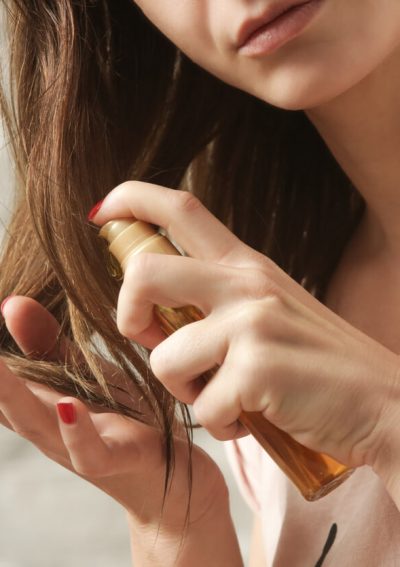Can Hair Straightening Products Cause Cancer?
Women who use hair straighteners may be at greater risk of developing uterine cancer, according to a recent National Institutes of Health study. Hair relaxers have previously been linked to bladder and breast cancer. Many hair straightening products contain hormone-disrupting chemicals and carcinogens.

How Can Hair Straighteners Cause Cancer?
Many hair straightening or hair smoothing products contain formaldehyde, also known as formalin and methylene glycol. When stylists apply the hair relaxing solution to hair and then apply heat, usually with a flat iron, formaldehyde is released into the air.
Formaldehyde is a colorless, strong-smelling gas that presents a health hazard when breathed into the lungs or when it gets into the eyes or onto the skin. The International Agency for Research on Cancer classifies formaldehyde as a human carcinogen based on nasopharyngeal cancer and leukemia studies.
Other chemicals found in hair straighteners include parabens, bisphenol A and metals. These compounds may also significantly increase cancer risk. Hair straightener side effects can include hair loss, eczema and a change in hair color.
Which Cancers Have Been Linked to Chemical Hair Straighteners?
The findings of the new 2022 study on chemical hair straightening provide the first epidemiologic evidence of an association between the use of straightening products and uterine cancer. While more research is required to replicate results and identify the specific chemicals associated with uterine cancer, the scientists conducting the study found that the risk more than doubled among women who reported frequent use of hair straighteners.
Previously, research on cancers linked to chemical hair straighteners had been limited. Recently published studies, however, reported risk increases above 25% for hair straightener use associated with breast and bladder cancer.
Studies also highlight a potential difference in risks based on ethnicity. Many hair products contain endocrine-disrupting compounds and carcinogens potentially relevant to breast cancer. Products used predominantly by black women may contain more hormonally active compounds.
Hair Relaxer Brands Linked to Cancer
The 2022 study linking chemical hair straightening products to cancer did not include specific brands, but listed parabens, bisphenol A, metals and formaldehyde as chemicals linked to uterine cancer.
Several chemical hair straightener lawsuits have been filed that allege the makers of the straighteners listed in the cases knew or should have known that their products increased the risk of cancer but manufactured and distributed them anyway, while giving no warning to consumers about risks.
- Dark and Lovely
- Just for Me
- L’Oreal
- Motions
- Namaste
- Olive Oil Girls
- Optimum
- Soft & Beautiful
- Strength of Nature Global LLC
- TCB Naturals
The lawsuits seek damages to compensate the women involved for their pain and suffering. They also seek compensation for costs associated with medical bills and other economic damages.
What to Do After a Chemical Hair Relaxer Cancer Diagnosis
If you’ve been diagnosed with cancer, your doctor and other specialists will work together to create an overall treatment plan. Treatment options depend on several factors, including type and stage of cancer, possible side effects, overall health, age and personal preferences.
Treatments for uterine cancer include surgery (such as a hysterectomy), radiation, chemotherapy and hormone therapy. If you’re concerned that exposure to harmful products caused your cancer, you may want to speak with a personal injury lawyer to explore a possible claim.
13 Cited Research Articles
Consumernotice.org adheres to the highest ethical standards for content production and references only credible sources of information, including government reports, interviews with experts, highly regarded nonprofit organizations, peer-reviewed journals, court records and academic organizations. You can learn more about our dedication to relevance, accuracy and transparency by reading our editorial policy.
- Novack Jones, D. (2022, November 21). Hair straightener lawsuits mount following government cancer study. Retrieved from https://www.reuters.com/legal/legalindustry/hair-straightener-lawsuits-mount-following-government-cancer-study-2022-11-21/
- Chang, C.-J. et.al. (2022, October 17). Use of Straighteners and Other Hair Products and Incident Uterine Cancer. Retrieved from https://academic.oup.com/jnci/advance-article/doi/10.1093/jnci/djac165/6759686?login=false
- Hatsbach de Paula, J.N., Basilio, F.N.A. & Mulinari-Brenner, F.A. (2022, March). Effects of chemical straighteners on the hair shaft and scalp. Retrieved from https://www.sciencedirect.com/science/article/pii/S0365059621003147
- U.S. Food & Drug Administration. (2022, February 25). Hair Smoothing Products That Release Formaldehyde When Heated. Retrieved from https://www.fda.gov/cosmetics/cosmetic-products/hair-smoothing-products-release-formaldehyde-when-heated
- Amarello, M. & Benesh, M. (2021, June 15) Steer clear of formaldehyde-releasing hair-smoothing treatments. Retrieved https://www.ewg.org/news-insights/news/steer-clear-formaldehyde-releasing-hair-smoothing-treatments
- Kang, D. et. al. (2021, April 12) Formaldehyde exposure and leukemia risk: a comprehensive review and network-based toxicogenomic approach. Retrieved from https://genesenvironment.biomedcentral.com/articles/10.1186/s41021-021-00183-5
- U.S. Food & Drug Administration. (2021, March 2). Formaldehyde in Hair Smoothing Products: What You Should Know. Retrieved from https://www.fda.gov/consumers/consumer-updates/formaldehyde-hair-smoothing-products-what-you-should-know
- Rabin, R.C. (2020, October 21). The F.D.A. Wanted to Ban Some Hair Straighteners. It Never Happened. Retrieved from https://www.nytimes.com/2020/10/21/health/brazilian-blowout-formaldehyde-fda.html
- Eberle, C.E. et. al. (2019, December). Hair dye and chemical straightener use and breast cancer risk in a large US population of black and white women. Retrieved from https://onlinelibrary.wiley.com/doi/full/10.1002/ijc.32738
- National Institute of Occupational Safety and Health. (2019, November 15). Formaldehyde – Reproductive Health. Retrieved from https://www.cdc.gov/niosh/topics/repro/formaldehyde.html
- National Cancer Institute. (2019, February 14). Formaldehyde. Retrieved from https://www.cancer.gov/about-cancer/causes-prevention/risk/substances/formaldehyde
- New York State Department of Health. (2017, May). Consumer Health Alert: Hair Straightening Products and Formaldehyde. Retrieved from https://www.health.ny.gov/environmental/chemicals/formaldehyde/consumer.htm
- National Institutes of Health. (n.d.). The Sister Study. Retrieved from https://sisterstudy.niehs.nih.gov/English/about.htm
Calling this number connects you with a Consumer Notice, LLC representative. We will direct you to one of our trusted legal partners for a free case review.
Consumer Notice, LLC's trusted legal partners support the organization's mission to keep people safe from dangerous drugs and medical devices. For more information, visit our partners page.
866-461-6220



